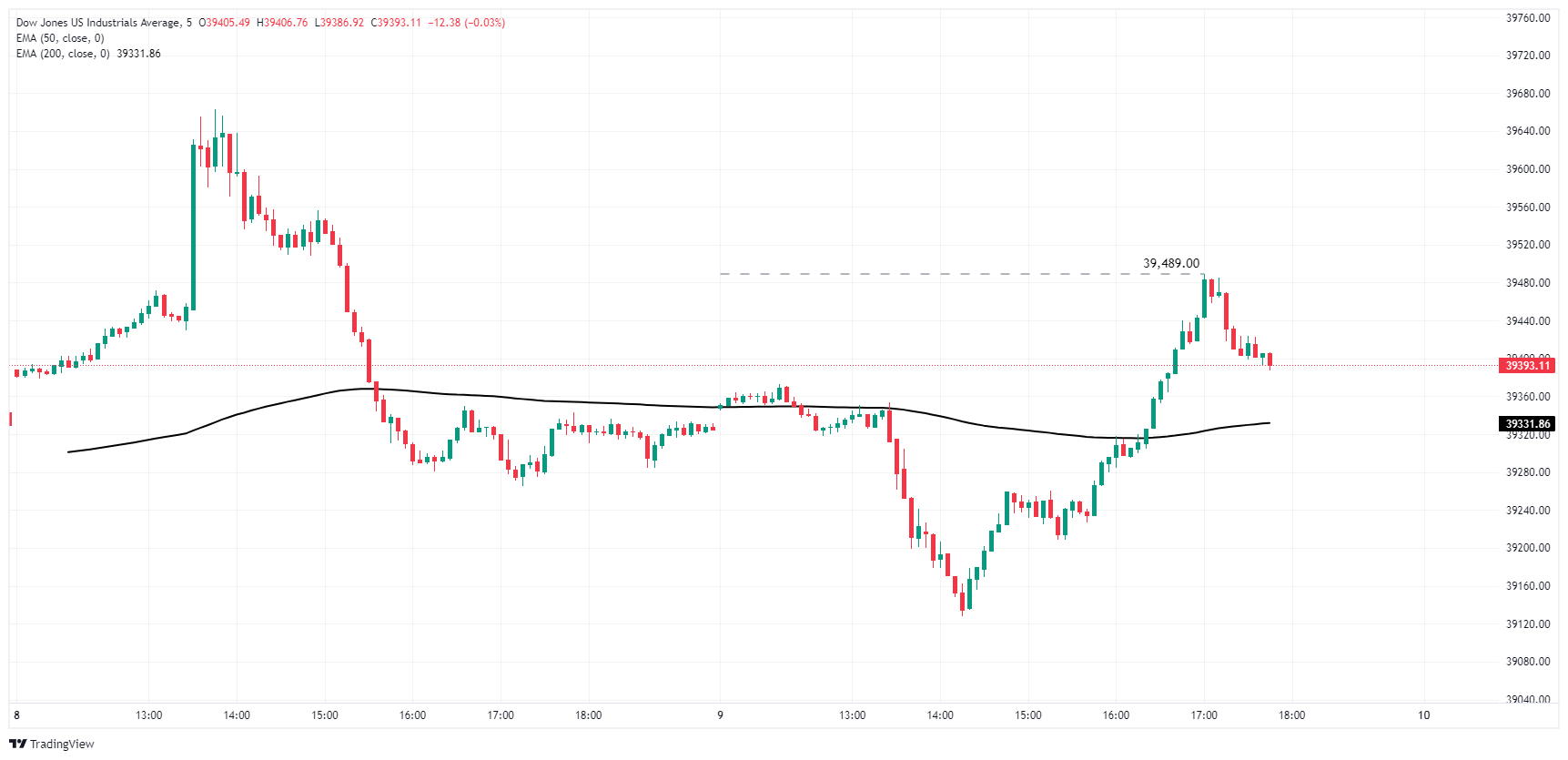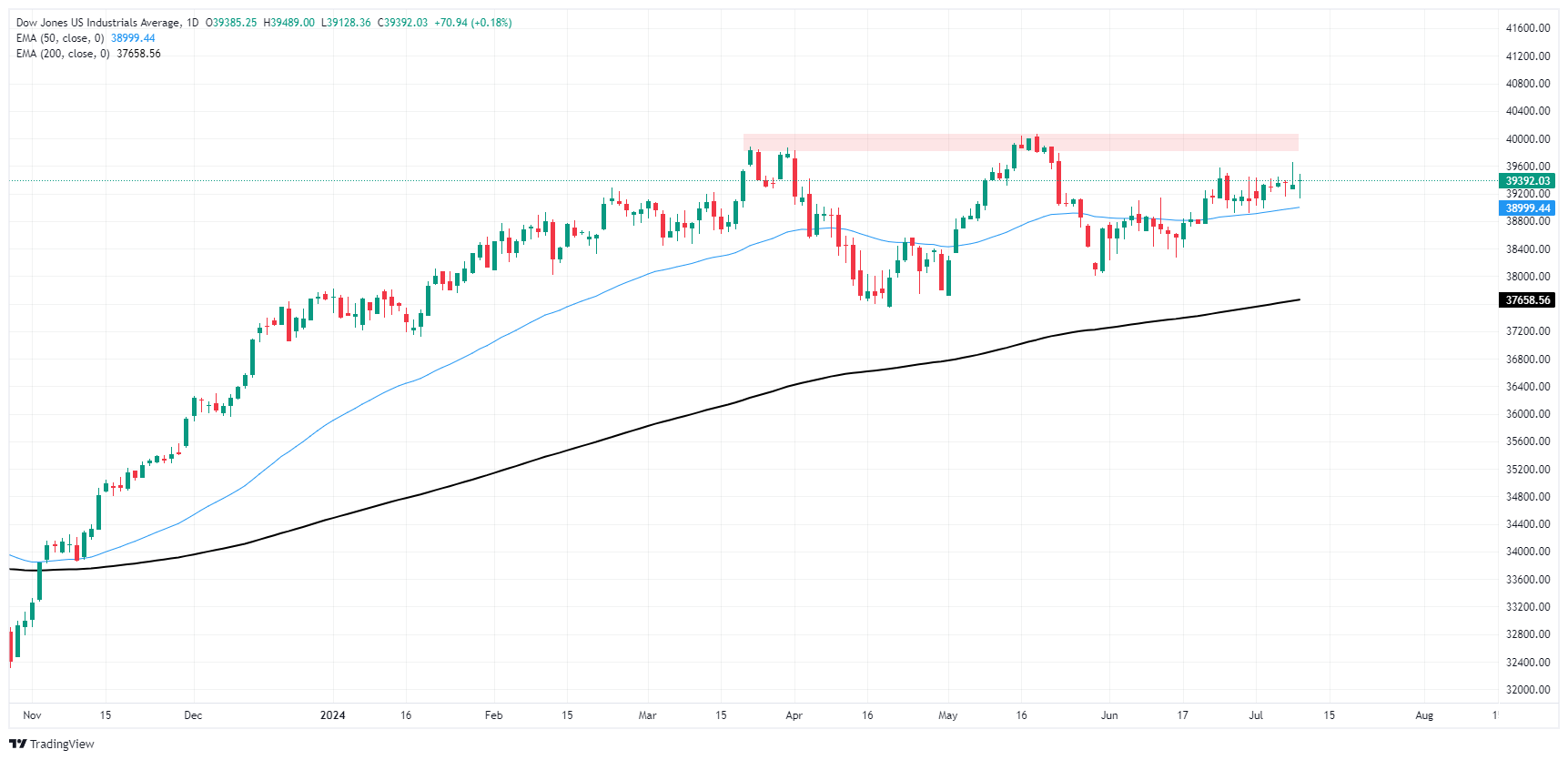- The Dow Jones reversed an initial decline and rebounded higher on Tuesday.
- The Fed’s comments were more hawkish than expected, rattling investor sentiment.
- The long wait for Fed rate cuts continues as US inflation data looms
He Dow Jones Industrial Average (DJIA) The U.S. dollar fell in early trading on Tuesday after Federal Reserve (Fed) Chairman Jerome Powell laid out less dovish talking points than expected while testifying on the Fed’s semiannual Monetary Policy Report in the first of two appearances in as many days. Market sentiment rebounded after the fact, and the Dow Jones rebounded higher for the day.
On Tuesday, Fed Chairman Jerome Powell presented the Fed’s semi-annual Monetary Policy Report to the Senate Committee on Banking, Housing and Urban Affairs. He emphasized the Fed’s commitment to wait for inflation to decline toward the 2% annual target, which disappointed investors who were hoping for signs of interest rate cuts. As a result, risk appetite declined and the US dollar strengthened.
Jerome Powell will deliver the second half of his report to the House Financial Services Committee on Wednesday, with no change in rhetoric or new information expected.
Later in the week, the US Consumer Price Index (CPI) inflation for June is scheduled for release on Thursday, followed by the US Producer Price Index (PPI) wholesale inflation on Friday. The core CPI in June is expected to remain at 3.4% year-on-year, while the core PPI for the same period is projected to rise to 2.5% from 2.3% in the previous period. Meeting these forecasts could disappoint markets expecting a quarter-point rate cut by the Fed at the September 18 rate meeting due to anticipation of a slowdown in inflation.
Dow Jones News
Even though more than half of the Dow Jones index was in the red on Tuesday, strong gains at the top of the board dragged the overall stock average higher. Bank stocks led the gainers, with Goldman Sachs Group Inc. (GS) up 2.77% to $477.89 per share, followed by JPMorgan Chase & Co. (JPM) up nearly 2% above $209.00 per share.
On the downside, Salesforce Inc. (CRM) is down -1.91% on the day, struggling at $252.00 per share as the customer tracking software company finds a halting recovery on promises of further AI integration into the company’s offerings.
Dow Jones Technical Outlook
The Dow initially slumped on Tuesday, falling toward 39,120.00 before a strong recovery that set an intraday high of 39,489.00. The DJIA is poised to pull back to Tuesday’s opening bids near 39,360.00.
The daily candles continue to rotate in the mid-range as price action is compressed between the 50-day exponential moving average at 38,998.14 and a valued supply zone near the 40,000.00 area.
Dow Jones five minute chart
Dow Jones daily chart
The Dow Jones
The Dow Jones Industrial Average, one of the world’s oldest stock market indexes, is made up of the 30 most actively traded stocks in the United States. The index is weighted by price rather than capitalization. It is calculated by adding up the prices of the component securities and dividing by a factor, currently 0.152. The index was founded by Charles Dow, also founder of the Wall Street Journal. In recent years it has been criticized for not being sufficiently representative, as it only tracks 30 companies, unlike broader indexes such as the S&P 500.
There are many factors that drive the Dow Jones Industrial Average (DJIA). The main one is the aggregate performance of the companies that comprise it, as revealed in quarterly corporate earnings reports. US and global macroeconomic data also contribute, as they influence investor confidence. The level of interest rates, set by the Federal Reserve (Fed), also influences the DJIA, as it affects the cost of credit, on which many companies rely heavily. Therefore, inflation can be a determining factor, as well as other parameters that influence the decisions of the Federal Reserve.
Dow Theory is a method for identifying the major trend of the stock market developed by Charles Dow. A key step is to compare the direction of the Dow Jones Industrial Average (DJIA) and the Dow Jones Transportation Average (DJTA) and only follow trends where both move in the same direction. Volume is a confirmation criterion. The theory uses elements of peak-trough analysis. Dow Theory posits three phases of a trend: accumulation, when smart money starts buying or selling; public participation, when the general public joins the trend; and distribution, when smart money leaves the trend.
There are several ways to trade the DJIA. One is to use ETFs that allow investors to trade the DJIA as a single security, rather than having to buy shares of all 30 companies that comprise it. A prominent example is the SPDR Dow Jones Industrial Average ETF (DIA). Futures contracts on the DJIA allow traders to speculate on the future value of the index, and options provide the right, but not the obligation, to buy or sell the index at a predetermined price in the future. Mutual funds allow investors to purchase a portion of a diversified portfolio of DJIA securities, providing exposure to the overall index.
Source: Fx Street
I am Joshua Winder, a senior-level journalist and editor at World Stock Market. I specialize in covering news related to the stock market and economic trends. With more than 8 years of experience in this field, I have become an expert in financial reporting.







